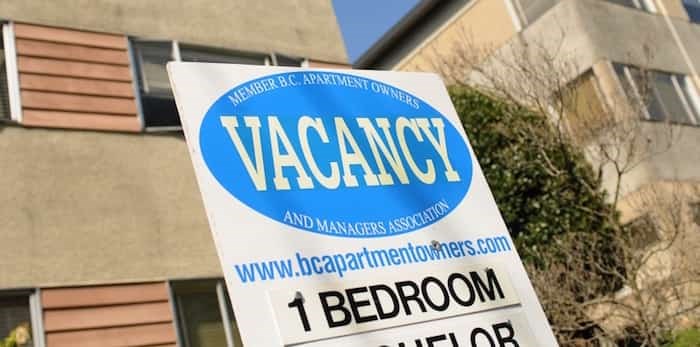
The rental vacancy rate may have eased slightly across all of Metro Vancouver, but it has headed in the other direction within Vancouver’s city limits, according to new annual data released November 28 by the Canada Mortgage and Housing Corporation (CMHC).
The federal housing agency said that, after loosening slightly to 0.9 per cent in 2017, vacancies in Vancouver proper over the past year have declined to 0.8 per cent of total rental housing stock.
That compares with Metro Vancouver’s rate, which has slackened from 0.9 per cent to 1.0 per cent this year, as new rental supply came on stream in some suburban municipalities.
The average rent in Vancouver proper rose 6.1 per cent to $1,478 over the past year, said CMHC. One-bedroom units also rose 6.2 per cent to $1,411 on average, and bachelor/studio apartments also increased by 6.2 per cent to $1,198 on average. These price rises contradict recent reports that Vancouver rents have flatlined over the past year.
CMHC also broke down vacancies and rents by neighbourhood. It found the lowest vacancy rate in Southeast Vancouver, at a very tight 0.2 per cent, with Mount Pleasant/Renfrew Heights, Marpole and South Granville/Oak all at 0.5 per cent, and the West End at 0.6 per cent. Downtown Vancouver, where there is a larger supply of rental units, had a vacancy rate of 1.2 per cent – down from 1.3 per cent in fall 2017.
The highest average rents were in downtown Vancouver, at $1,645, up 4.8 per cent from a year ago. The lowest rents within the city limits were found in East Hastings, with its $1,238 average rent an annual increase of 5.6 per cent. The steepest jump in average rents was English Bay, up 8.3 per cent to $1,597.
Outside of Vancouver proper, a flood of new rental units in Burnaby pushed that city’s very low 2017 vacancy rate of 0.6 per cent all the way up to 2.0 per cent this year. New Westminster also saw rates ease from 1.1 to 1.6 per cent, although average rents rose more than eight per cent year over year, with high-priced new-build apartments coming on stream. North Vancouver (District), West Vancouver, Delta and Richmond also saw slight vacancy rate increases this year. This drove Metro Vancouver’s overall vacancy rate up to 1.0 per cent.
Surrey, on the other hand, joined Vancouver in a tightening rental market, down to an incredibly low 0.4 per cent compared with 0.6 per cent last year. Surrey has recently seen the launch of the first new rental purpose-built building in the city in more than three decades.
The CMHC said that a strong Metro Vancouver economy and the high cost of entry-level homeownership is fuelling rental demand.
Check out the full Metro Vancouver report to see vacancy rates and rental prices by neighbourhood.


